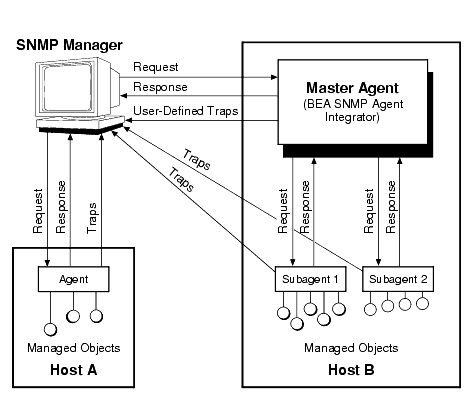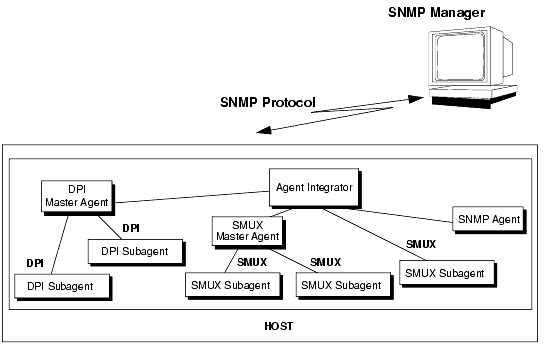SNMP Agent Administration Guide
|
|
Setting Up the BEA SNMP Agent Integrator
The following sections provide information about the BEA SNMP Agent Integrator and describe the procedure to install the BEA SNMP Agent Integrator:
- About the BEA SNMP Agent Integrator
- Configuring the BEA SNMP Agent Integrator
- Starting the BEA SNMP Agent Integrator and Subagents on a Windows System
- Starting the BEA SNMP Agent Integrator and Subagents on a UNIX System
- Stopping the BEA SNMP Agent Integrator and Subagents on a Windows System
- Stopping the BEA SNMP Agent Integrator and Subagents on a UNIX System
About the BEA SNMP Agent Integrator
The BEA SNMP Agent Integrator enables multiple agents and subagents from any vendor to cooperate in managing diverse hardware and software components on a single host. It makes possible the extended SNMP manager/agent model shown in the following figure.
Figure 5-1 SNMP Manager/Agent Model
The BEA SNMP Agent Integrator enables you to:
- Run multiple peer SNMP agents on a single managed node.
All communication between the agents and the SNMP manager is handled through the BEA SNMP Agent Integrator master agent.
- Off-load polling from the management station to reduce network traffic and reduce load on the network manager.
User-defined rules enable the BEA SNMP Agent Integrator to check for the occurrence of significant system events and send alarms or execute programs when the events are detected. Communication over the network occurs only when an event is detected or when polling activity from the manager is started or stopped.
- Manage system resources using multiple SNMP multiplexing (SMUX) subagents.
The BEA SNMP Agent Integrator uses the SMUX protocol defined in RFC 1227 to respond to the SMUX subagents and fans out requests from an SNMP-compliant system or network management station to the appropriate subagent.
- Manage system resources using any other master agent/subagent protocol, such as Distributed Program Interface (DPI), where the master agent responds to SNMP management requests.
The DPI master agent uses SNMP to respond to requests from network managers. The DPI master agent can, therefore, be configured to communicate through the BEA SNMP Agent Integrator in the same manner as other peer SNMP agents.
- Coordinate communication between an SNMP manager and multiple SNMP agents on multiple network nodes.
This feature is particularly useful for off-loading polling to the BEA SNMP Agent Integrator to manage a distributed system whose components are spread over a number of computers. To the BEA SNMP Agent Integrator, the managed resources appear as if they are on a single computer. For more information, see Using the BEA SNMP Agent Integrator for Polling.
- Listen on UDP port 161 and handle all communications with the SNMP manager.
The following figure summarizes how the BEA SNMP Agent Integrator master agent can control an assortment of master agents, SNMP agents, and SMUX subagents.
Figure 5-2 BEA SNMP Agent Integrator Master/Subagent Architecture
The various agents and subagents all appear to the SNMP manager as a single SNMP agent. The BEA SNMP Agent Integrator acts as a proxy for the SNMP manager.
The BEA SNMP Agent Integrator can run on the same node with any master agent/subagent architecture as long as the master agent uses SNMP to respond to management requests.
Configuring the BEA SNMP Agent Integrator
The BEA SNMP Agent Integrator uses the following environment variables:
Indicates the password that a SMUX subagent must use when re-establishing communication with the BEA SNMP Agent Integrator.
Indicates the number of times the BEA SNMP Agent Integrator retries sending an SNMP request to peer SNMP agents when no response is received within the established timeout interval.
Modifies the default time interval that the BEA SNMP Agent Integrator waits for a reply to a request sent to a SMUX subagent or an SNMP peer agent. This value can also be set by adding a
BEA_PEER_MAX_WAITentry to the BEA SNMP Agent configuration file.If this environment variable is not set, and there is no
BEA_PEER_MAX_WAITentry in the configuration file, the default is three seconds. For peer SNMP agents, the default timeout value can be overridden for individual SNMP agents using the timeout parameter inNON_SMUX_PEERentries in the BEA SNMP Agentbeamgr.confconfiguration file.(Note that "peer SNMP agent" and "non-SMUX peer agent" are identical terms. A peer SNMP agent, or a non-SMUX peer agent, is an SNMP agent running under the BEA SNMP Agent Integrator.)
Once you have set up BEA SNMP Agent according to the instructions in Setting Up BEA SNMP Agent on a Managed Node, perform the following step to set up and use the BEA SNMP Agent Integrators:
The peer SNMP agents can be on the same managed node (IP address) as the BEA SNMP Agent Integrator, or they can be on remote nodes. Access to the objects managed by the peer SNMP agents is defined through
NON_SMUX_PEERentries in thebeamgr.confconfiguration file. Each entry defines or moves a branch of the OID tree that is accessible via that agent. This task is described in Using Multiple SNMP Agents.- Indicate the managed objects that are available (if any) through Distributed Program Interface (DPI) master agents.
Because a DPI master agent speaks SNMP, it appears to the BEA SNMP Agent Integrator as just another peer SNMP agent. Setting up access to DPI subagents is thus done the same way as setting up access to peer SNMP agents, as described in Step 1.
You can modify a SMUX subagent's management scope—for example, to avoid conflicts with other agents—by specifying
OID_CLASSentries in thebeamgr.confconfiguration file. By default, a SMUX subagent automatically indicates the section of the OID tree for which it is responsible when it registers with the BEA SNMP Agent Integrator master agent. The syntax forOID_CLASSentries is defined in Configuration Files.- Define local polling rules and the actions to be taken by the BEA SNMP Agent Integrator if user-defined thresholds are crossed.
This step is necessary only if you want to use the BEA SNMP Agent Integrator to off-load polling from the management station. Polling rules are defined through
RULE_ACTIONentries in thebeamgr.confconfiguration file. Polling is automatically active when the BEA SNMP Agent Integrator starts. BEA SNMP Agent Integrator local polling can be de-activated or re-activated from a management station using SNMP Set commands. BEA SNMP Agent Integrator polling rules, and how to start and stop polling, are described in Using the BEA SNMP Agent Integrator for Polling.- Configure your SNMP management framework for the BEA SNMP Agent Integrator. For more information, see Integrating BEA SNMP Agent with a Management Framework.
Configure the management system for BEA SNMP Agent Integrator traps. Some configuration is required on your SNMP-compliant management framework to make use of SNMP trap notifications that are generated by the BEA SNMP Agent Integrator.
The exact set of steps you need to perform vary depending upon which management system you are using. Typically, some configuration or mapping is required to get the management system to perform a desired action (such as turning an icon red) when a trap is received. Consult your management system documentation for specific instructions.
These entries are supported by the BEA SNMP Agent Integrator in the MIB-II snmp group.
If you are using a BEA SNMP agent as a SMUX subagent to manage BEA Tuxedo applications, configure the BEA SNMP Agent Integrator timeout to at least 30 seconds. To do this, add a BEA_PEER_MAX_WAIT entry to the BEA SNMP Agent beamgr.conf configuration file as follows:
Another way you can set the timeout value is to set the environment variable BEA_PEER_MAX_WAIT to 30. For C shell on UNIX systems, for example, use this command:
prompt> setenv BEA_PEER_MAX_WAIT 30
Starting the BEA SNMP Agent Integrator and Subagents on a Windows System
To start the BEA SNMP Agent Integrator and SMUX subagents on a Windows system, follow these steps:
Note: For any tux_snmpd process started as a non-SMUX peer agent (-s option specified at startup), you must start that process before starting the BEA SNMP Agent Integrator. The starting order for BEA SNMP Agent is as follows: start all non-SMUX peer agents, then the BEA SNMP Agent Integrator, and then all SMUX subagents.
Starting the BEA SNMP Agent Integrator and Subagents on a UNIX System
To start the BEA SNMP Agent Integrator and SMUX subagents on a UNIX system, log in as root and start the following programs in the specified order:
Note: For any tux_snmpd process started as a non-SMUX peer agent (-s option specified at startup), you must start that process before starting the BEA SNMP Agent Integrator. The starting order for BEA SNMP Agent is as follows: start all non-SMUX peer agents, then the BEA SNMP Agent Integrator, and then all SMUX subagents.
Stopping the BEA SNMP Agent Integrator and Subagents on a Windows System
To stop the BEA SNMP Agent Integrator or one or more subagents on a Windows system, follow these steps:
Stopping the BEA SNMP Agent Integrator and Subagents on a UNIX System
To stop the BEA SNMP Agent Integrator or one or more subagents on a UNIX system, issue the following command:
prompt> stop_agent logical_agent_name | all [logical_agent_name]
For all SNMP agents other than tux_snmpd, the logical_agent_name is always the name of the executable. If you specify all, all SNMP agents are stopped.

